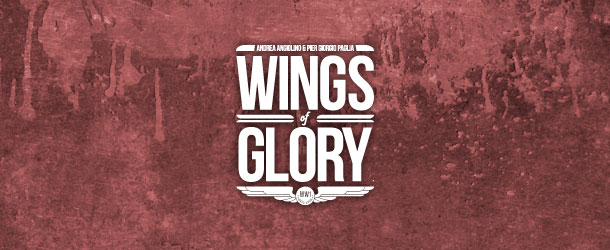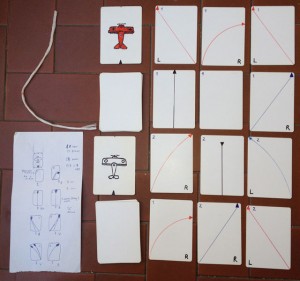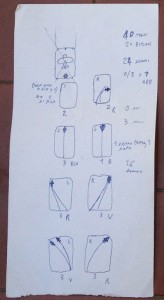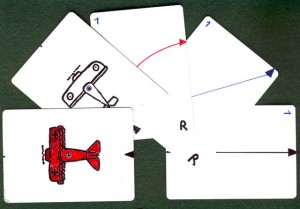by Andrea Angiolino
Andrea Angiolino, together with Pier Giorgio Paglia, is the author of the Wings of Glory system (previously published under the name of Wings of War). In this article, Andrea tells the story of the “roots” of this best-selling game, just at the time when it’s appearing in its most polished version ever, the WW1 Wings of Glory Rules & Accessory Pack.
A question that is often discussed among game designers is how much a prototype must be nice-looking when proposed to a publisher. There is no clear answer - an intelligent publisher will look with the same interest to gorgeous materials and to rough but clear and efficient ones, while anyway a beautiful presentation cannot do any harm to the success of the project.
Anyway, this picture shows something that is far earlier than anything ready to be shown around for evaluation. This is the fruit of the first night of work on the concept that brought to Wings of Glory: a very simple and quick card game about aerial dogfights, visualized by players "flying" their airplane cards on a table. The idea was to use materials as “compact” as possible to make the game experience simple and easy: maneuver cards should replace all the paper & pencil planning used in old simulations of the '70s and '80s, such as Air Force or Aces High, while at the same time becoming the templates regulating movement, like in a miniature wargame; a damage deck would replace all the charts, dice rolls and again paper & pencil notations, to resolve firing, damages and other special events related to combat (such as jammings and explosions).
The leaflet on the left of the picture is the project: the initial flash of inspiration written down on paper. It was a night of February 2002, in my home in Capranica, a medieval village close to Rome. A leftover of paper was taken from the basket near the fireplace (environmental awareness prevented the use of a brand new sheet for such a small task) and with the help of a ballpoint pen, the idea was put down.
The airplane card was the first to be drawn. It has a center to measure firing ranges: a piece of string with a red sign at the half will be used, with the first half of the string indicating short range, and the second half long range. A mark in front of the card and an arrowhead on the rear are drawn to allow the use of maneuver cards. Diagonals are marked on the drawing to remember how to define the firing cone: it goes from the center to the limits of the straight part of the front of the card, rounded corners excluded. Its limits are clear, so there is no need to draw the cone on the plane cards.
Then, maneuver cards were designed: at first, with arrows as wide as half of the card, then corrected to fully use the available width. Even if the idea was already to have different decks for different plane models, to make things simpler the first deck designed was done in two copies and used both with a Sopwith Camel and with a Fokker Dr.I. Anyway it was already customized for them: you can notice that there are two 90° turns to the right and none to the left, to represent their rotary engine. The Camel was a tricky plane, dangerous and sometimes fatal to inexperienced rookies, but it allowed expert pilots to use the torque effect of the engine for tight turns to the right. Some veterans even reported in their diaries that it was easier to turn 270° right than 90° left. This is the reason for the asymmetry in the maneuvers available.
The final released decks will be different for Dr.I and Camel, not only to take into account a sensible difference of speed but also because, after further study, I discovered that the design of the Dr.I partly corrected the torque effect - this is the reason why it will have two 90° right turns in the final version of the game instead than 3 as the Camel. But in the first night of prototyping, it was not the time for polishing the game yet... Two identical sets of maneuvers were considered fair enough as a solution. As in the inspirational Ace of Aces booklet game, after all.
Each card has a letter in a corner to mark the maneuver as Left, Straight or Right. The number under the card is its quantity in each deck: 2 stalls, 2 right turns, 3 straights, 1 Immelmann turn and so on. There are 3 of each of the most basic maneuvers, because each turn 3 cards have to be used. Under the card drawing there is also a color: B for blue, R for red, V for green ("blu", "rosso", "verde" - directions' first letters are in English, colors in Italian). This is the color in which the arrows were to be drawn on cards. The idea was to limit the ability to turn: after a red card you could do a green one, after a green one you could not do a red one. The intention was to design, in a very simplified way, a system to keep the banking of the plane into account. After speaking with a pilot and thinking more about the game flow, simplicity was to prevail and this limitation on the choice of maneuvers was very soon abolished.
There are some notes besides a couple of special cards. The stall is a totally blank "straight" card, with the idea that, , when the stall is revealed, the plane stays where it is. The "no 2 in a row" note is the first, hastily done rule for acceleration. Beside the card for the Immelmann maneuver, a "1 straight before, 1 after" note is marked. On the upper right corner there is a card list: 36 maneuvers, 2 biplanes and 28 damages, then corrected to 40 maneuvers, 2 biplanes and 24 damages. The total is 66 cards in both cases. The idea is to fill a standard print sheet with all that is needed to play for 2 people, but a 55 poker cards sheet is probably not enough.
Besides, I was just back from the Nuremberg Fair and I had a clear idea that a war themed game would have been refused by any major German game publisher; but I had a chance to speak with Adlung, that published only 66 cards games. So I thought that I could use their standard format and maybe even propose the game to them for a German edition. Actually, I did so at the next Nuremberg fair, in January 2003, but they declined: "We publish only 66 cards games, and this is a “66 cards and a piece of string” game" they correctly noted. In any case, the general idea was to have a little package that could be bought by one person to play in 2. Further packs with different airplanes could then be acquired to try different airplane models, to introduce different elements, such as two-seaters and bombers, and to increase the number of people that could play together.
The damage deck is defined as 24 cards ranging from 0 to 8 points of damage, and one "shot down" card ("abb" being the first letters of "abbattuto", i.e. “shot down”). The first instinct was to include two of those cards, but the 2 is not even finished and it is immediately replaced by a 1 - not only for kindness to players but also probably thinking that, in a 2 planes match, one elimination card is enough and after it appears the second is not needed any more. The presence of 0s in the deck is to support the idea that the game will neither have dice, nor "to hit" procedures: when determining the effects of an attack, the card will indicate both if the target is hit and how much it is damaged. The two "0 xxx" and "3 xxx" notes are a little reminder that further effects will be written on cards, both missing and hitting the target, such as jammings (on the 0s) or special damages (when there are damage points marked on the card). The last note on the right of the leaflet says "16 danni", that is, “16 damages”. This is the total amount of punishment that each of the two planes in the prototype can suffer. The idea is to have a single tally of damages, not different ones for wings, fuselage, tails, engine and so on, as in most of the simulation board games that were then available. The choice is not only motivated to keep things as simple as possible, but also because the localization of hits was not considered so realistic - a later conversation with my friend Gregory Alegi, aviation historian, will confirm the correctness of this solution that will be kept in the released game too.
There is nothing missing of the core concepts of the complete system that today requires a fat rulebook to explain! Altitude rules, for examples, do not appear on the leaflet because they are deliberately left out of the game, at least in its basic version - after all they were not considered an essential element in other successful dogfight games previously published.
Just after finishing the "project", the prototyping started. I usually make games with any scrap material I find at hand. For cards, I usually use old packs of visiting cards from previous job, or some perfect cuts of cardboards that my father brought home from a printer when I was a kid, to me to play. But in this case a real luxury has been used: one of many blank decks of cards that the Belgium printing company Carta Mundi gave me as a present to use for my prototypes. The best thing to write on them are the permanent felt pens for CDs and plastic. I had not a green one at home, so the maneuver arrows became blue, black and red instead. Black has been enough also to draw a cartoonish Camel, while the Dr.I had of course be filled in red. "1" and "2" ID numbers have been added on the cards to easily separate the two decks before playing. Being in a kitchen helped to draw clean and nice curves on the cards: the trick was jus to find the correct pan or dish to put on each card as a guide for the pen.
These cards have more or less the same size of regular poker/Magic - The Gathering cards; it will be Roberto Di Meglio, the first publisher to believe in this little silly game and the man who made it into a real product, to change the format to smaller cards, so that the game could be played in a reduced space.
The last step was to write down damages on further cards. Done that, the first game could be played on the very kitchen table where it has been prepared. The night of work was concluded… at last, play could start!











Follow Us on